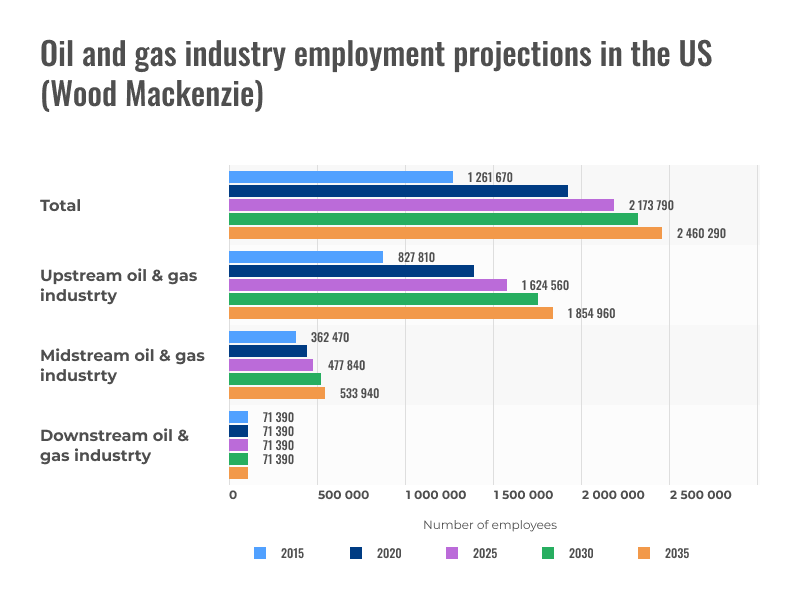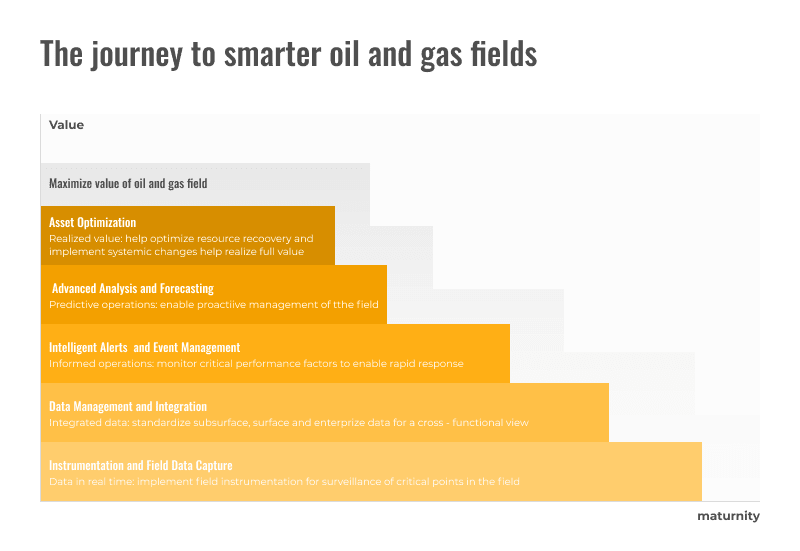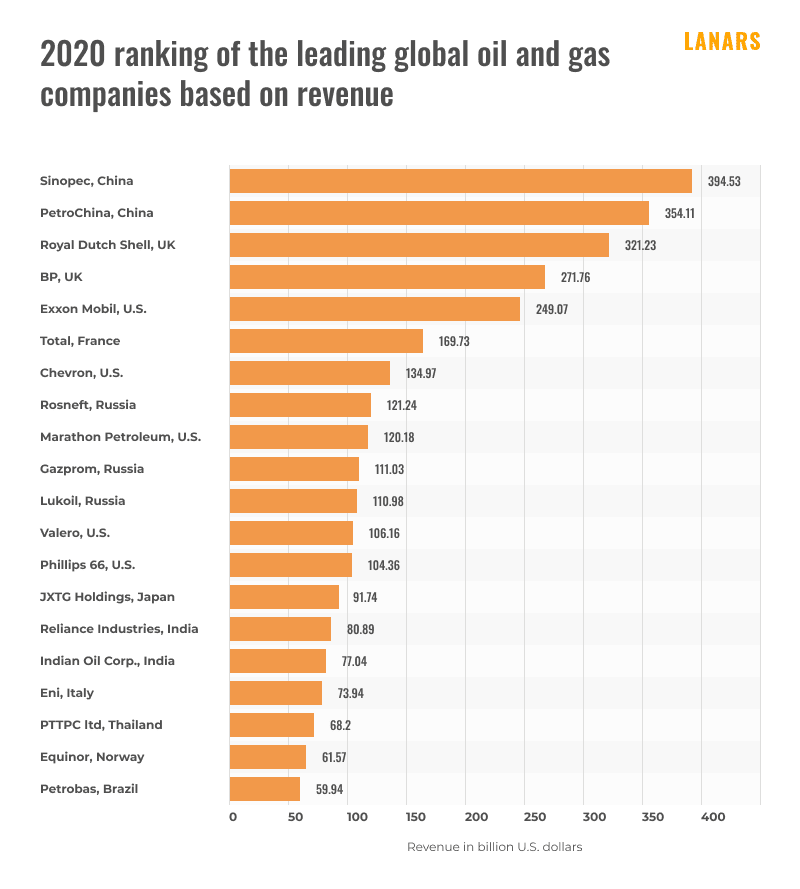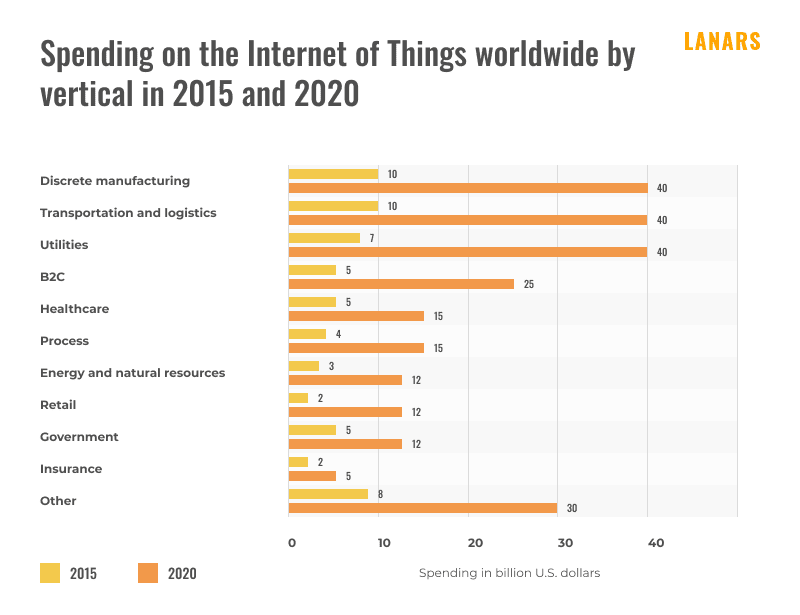It is no secret that the oil and gas industry generates huge capital every year, and for some countries the entire state budget is built on the profits from the extraction, processing, and transportation of oil and gas products. Obviously, digitalization has not bypassed this area. It is forecast that by 2023, the market for software and IoT devices for oil and gas will be worth almost $40 billion.
The technologies that are currently applied (or are planned to be used) at oil and gas enterprises are very diverse. They include industrial automation systems, sensor networks for oil asset monitoring, and software for monitoring the safety levels at industrial units.
In this article, experts from Lanars, a company that develops complex solutions concerning the implementation of IoT in the oil and gas industry, talk about the specifics of work for this industry and promising IoT oil and gas use cases.
Challenges in the Oil and Gas Industry
IoT in the oil and gas industry is not a phenomenon of recent years. Various algorithms for optimizing production, improving its quality, and preventing equipment breakdown have been used for a long time.
Before we dive into the challenges concerning solutions for the oil and gas industry, let’s briefly mention 3 types of companies that operate there. Downstream companies are focused on marketing and distribution, midstream business is about logistics, and the upstream sector covers research and production itself.
The tasks and challenges you may face while developing IoT applications in the oil and gas industry at every industry level differ a lot. However, there are also common issues such as the lack of niche experts, the high price of monitors, and the very strict safety and security standards you need to follow there.
Downstream
These companies benefit when they manage to sell oil and gas at the best price and use as few resources as possible on finding customers. If the product they sell is more competitive, the likelihood of high profits increases. In order to make it so, these companies must make an environment-friendly commitment and apply IoT for price and asset monitoring.
Midstream
Companies of this type are interested in optimizing logistics, as well as following strict observance of the rules for the transportation of oil and gas, including the temperature regime and routes. Midstream organizations are also focused on keeping their transport units in good technical condition and avoiding breakdowns.
The main challenge for servicing this sector from the IoT development companies point of view is the need to be up to date with the logistics regulations of certain regions.
Upstream
These companies spend a lot of money on the latest equipment, as well as technologies for finding deposits of raw materials and their efficient processing. They are interested in remotely controlling the processes of research and extraction of useful components.
The major challenges of designing equipment and software for upstream companies are connected with the environment you should deal with (aggressive substances, high pressure and extreme temperatures).
How can IoT-based technologies be useful for the upstream sector? They can simplify and make many processes more controllable within companies, as well as increasing the level of security of enterprises in general. Moreover, some innovative products such as smart oil and gas sensors can become part of the oil and gas monitoring system of a large corporation and allow upstream, midstream, and downstream businesses to cooperate effectively.
Smart Oil and Gas Monitoring Methods
As you may have perceived from the previous paragraph, most IoT solutions for the oil and gas industry are related to monitoring. This can be monitoring the storage conditions of oil or gas, oil analyzing, as well as monitoring equipment and the environment in order to remotely control processes.
In 2021, we can talk about 3 approaches to building a monitoring system using IoT in the oil and gas industry:
- PLC (programmable logic controller) systems
This is a wired IoT technology, which is one of the oldest IoT oil and gas use cases. Machine-2-machine systems of this type consist of numerous sensors interconnected by wires. The problem is that switching these devices takes a long time, and changing the configuration of the system requires a budget. When creating PLC systems, RS-232 and RS-435 standards are often applied.
- Satellite communications
This technology is expensive, but it has been widely applied to IoT in downstream oil and gas enterprises, and to a lesser extent in the midstream sector. Satellite communications have the advantage of being flexible: you can add any number of remote sensors as you need them. Such systems enable you to take remote control of production processes and reduce the number of people who are physically involved in production.
- Physical monitoring
Unfortunately, this approach is still the simplest, most flexible, and cheapest for business. In this case, you have no need for expensive and innovative IoT solutions for the oil and gas industry, since most of the monitoring tasks are performed by employees. But you can focus on making their working conditions safer with an automated safety system.
Check out another article to learn more about IoT — How Much Does It Cost to Develop an IoT App.
Why Should Oil Companies Use IoT?
These days, we can find hundreds of examples of custom solutions of IoT applications for the oil and gas industry designed to resolve various issues. In terms of business, investing in development, and then adopting a certain IoT innovation for oil and gas, increases the value of the company's products for clients, boosts its status, and reduces business maintenance costs in the long term.
Here are some examples of how you can benefit from the use of IoT in oil and gas.
Automation and control of the process
Automation can cover research, raw material extraction, manufacturing, transportation, and even tracking product demand areas. This approach makes it possible to save the company's budget and reduce its need for human resources.
Making big data-driven decisions
The future of IoT in oil and gas is not only about outsourcing ‘dirty’ tasks, but also about opening new horizons. The digitalization of this industry is giving stakeholders more insights for making smart decisions. Moreover, using IoT, it is possible to predict with high accuracy what is happening in the market and beyond.
Reducing the risk of accidents, leaks, and breakdowns
IoT adoption in the oil and gas industry is about how to make the industry safer for humans and the environment. Things like monitoring IoT devices for oil and gas working in conjunction with a security system can save lives.
Eco-friendliness and a better reputation
The key value of IoT in oil and gas for businesses is that such innovations make the sector more transparent and environmentally friendly. As a result, eco-friendly companies (that is, those that can prove they are not polluting the planet) gain a significant competitive advantage.
IoT Use Cases Regarding Oil and Gas Industry
There are numerous IoT oil and gas use cases. In fact, you can improve almost every aspect of your business by creating a network of smart interconnected devices. In this section, you will find just a few of the most popular examples of the use of IoT in oil and gas.
IoT Sensors
The adoption of IoT in the oil and gas industry started with smart sensors, which marked the process of mass transition from manual methods of controlling the safety and quality of manufactured products to the automation era. The sensors are used in gas and oil analysis during the research phase. Tanks for storing and transporting industrial fluids are almost always equipped with such devices.
Smart Analytics
IoT in upstream oil and gas is one of the most promising areas for applying the IoT technology. The upstream sector is the riskiest and most costly, so smart analytics, powered by local and global IoT data, can mitigate these risks.
Big data analytics are often used for revenue forecasting, logistics optimization, and automation of production processes. For example, there are IoT solutions for the oil and gas industry, which are aimed to fully automate production.
Managing Supply-Chains
Smart oil and gas sensors are a multifunctional tool that can simplify processes at every level of the industry. For example, you can install an oil and gas monitoring system at your customers' facility that will resupply them with resources when they are running low.
Industrial IoT in oil and gas also covers areas such as route management and oil transporter weight measurement. In addition, sensors can help you avoid dangerous situations when transporting oil or gas, as well as violations of the rules of such transportation in a specific geographic region.
Transport tanker temperature sensing and fleet tracking are tasks that, thanks to IoT, today are performed remotely and almost without human intervention.
Leak Detection
Real-time pipeline leak detection is an essential task, which can be simplified by IoT application in the oil and gas industry. Smart leakage sensors together with a real-time alert system reduce the risk for upstream and midstream companies that deal directly with extracting and transporting oil and gas. Methane gas detection is one of the most common cases of use of IoT in oil and gas.
The future of IoT in oil and gas is also associated with downstream companies that may invest in technology to make their product generate higher profits. Sometimes it is the downstream business that insists on installing remote area pipeline monitoring.
Tank Monitoring
IoT adoption in the oil and gas industry is also related to the remote monitoring of storage tanks for industrial liquids and other hazardous substances. The most common tank level and temperature monitors can be found on most upstream and midstream industrial units these days.
IoT devices for oil and gas also includes water pressure monitoring equipment and smart sensors for remote oil well monitoring. As a rule, such solutions are created taking into account the characteristics of a particular enterprise, in order to make it possible to monitor oil tanks remotely.
For three years, three teams worked on a single tank monitoring system: one from LANARS and two specialized foreign units. During the entire time of remote tank monitoring system (liquid concentration scan) development, design, and testing, ten specialists were involved full-time on the project.
The experience of the specialists we chose to complete the project ranged from three to fifteen years in their areas. Our main team consisted of iOS and Android engineers, Java, JavaScript, C ++, Python engineers, as well as specialists in embedded development, design, and manufacture of software boards.
Hardware solution: compact, autonomous, highly accurate sensors and a control unit for data storage and ancillary hardware made from plastic and aluminium
Software solution: a remote tank monitoring system which included software for sensors, mobile apps to collect data from sensors, datastorage, or transfer to the main controller, UX solutions, and integrations with the existing industrial software our client uses
As a result, the project extended the working life of industrial machines and made their maintenance less costly.
Steps for Adopting IoT in Your Oil & Gas Business
The introduction of IoT innovation for oil and gas often entails huge business transformations that are painful and costly. Before starting such a process, it is better to carry out a series of preparatory operations that will allow you to avoid budget overruns and other risks. Here's the way our team recommends you to move towards improving your business with cutting-edge IoT technologies:
Step 1. Clarify your task
The value of IoT in oil and gas can only be high for your business if you have a good understanding of the problem you need to solve with new software and equipment.
It is true that you can improve the efficiency of literally any department or production unit using IoT, however, it is always better to start with something small, controllable, and measurable. This can be introducing smart sensors for monitoring the temperature in a tank, or a system for monitoring the composition of a substance in a pipe for example.
Define your problem, analyze what positive consequences its solution will have, and only then start developing the solution itself.
Step 2. Search for ready-made hardware
Despite the fact that gas analyzing, oil asset monitoring, and smart oil and gas sensor production are areas that have only recently received impressive funding, there are many companies that specialize in developing ready-to-use hardware for all of those purposes.
You may find equipment that fits your requirements in the off-the-shelf device market. You should also consider that IoT devices, including tank and field sensors, are mostly quite adaptable.
The main thing at this stage is to determine whether you can find a ready-made hardware solution on the market or that you need to create it from scratch.
Step 3. Check if your new hardware is compatible with the existing one
The incompatibility of newer (usually more modern) Internet-connected equipment with older controllers or other monitoring devices is a common problem you may encounter. We recommend that you check the compatibility of old systems with new ones in advance.
Step 4. Get your data processing and protection to a truly competitive level
IoT-powered modernization at your company is not only about collecting data, but also about efficiently processing it and using it to make important decisions.
Think ahead about where you will apply the new data (for instance, data collected with friction points monitoring sensors) and how you can automate or optimize production using them. You will definitely need a team of engineers who can work out a data architecture, develop data processing algorithms, and configure the controllers.
Where there is a transfer of data from one device to another, there is always a risk of theft and hacking. In industrial IoT in oil and gas, the rates are high, so it is better to eliminate risks where possible by applying high-quality digital data protection.
Step 5. Set up your system and check the results
No matter how carefully you’ve designed your custom industrial IoT, there will always be room for improvement. Moreover, it is impossible to foresee some rare real-time issues with sensors and controllers.
Once the launch of the IoT at your industrial unit is complete, we recommend that you closely monitor the results. Use this to improve the system in the future and make your business even more efficient.
IoT Solutions for Oil and Gas by Lanars
The oil and gas industry still generates enormous capital (global industry revenue in 2020 was over $1.47 trillion, (even though there was a 40% decline year-on-year due to COVID-19). IoT is called one of the most profitable tech areas to invest in. That means combining both you can end up having a sustainable and efficient business with high quality and safety standards.
IoT in the oil and gas industry takes many forms, and some of them, including the use of smart interconnected sensors and remote controllers, is already considered the standard for upstream and midstream companies today.
Among the major benefits that you get from IoT adoption in the oil and gas industry are better control over production processes, a high level of security, business optimization based on big data, and a chance to reduce the prime cost of oil and gas products as well as their logistics. Lanars can offer you custom IoT solutions that help to achieve such results.
At Lanars, we have wide experience of cooperation with oil and gas businesses of downstream, midstream, and even upstream types and are ready to find or develop industrial the IoT hardware you need, as well as design software to make it work for your business.











Top comments (3)
In fact, these are all the same reasons that prevent the use of digital technology in other industries - the lack of sufficient information to make decisions. It's strange because there are resources like digitaloilandgas.solutions, which help solve such problems. Also, inadequate and inefficient risk assessment, lack of understanding of the consequences of decisions.
But machine learning technologies have come a long way in recent years, and they are now used everywhere. They are used to build weather forecasting models, detect anomalies, assess reliability and predict the behavior of complex systems, which creates hope for the future.
I know my reply is a bit late, but I’d like to drop in and say that it's fascinating to see how IoT is transforming the oil and gas industry, and it's exciting to learn about the specific use cases and technologies being applied. I found it particularly interesting how smart oil and gas sensors can be integrated into a monitoring system to improve safety and efficiency. The use of IoT sensors and smart analytics in upstream oil and gas can help companies optimize their production and prevent equipment breakdown, especially in challenging environments like those encountered in rotary drilling rigs. It's exciting to see how companies are developing complex IoT solutions tailored to the specific needs of the industry.
You have searched in a nice manner and explained them perfectly
Some comments may only be visible to logged-in visitors. Sign in to view all comments.